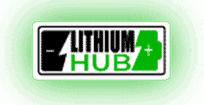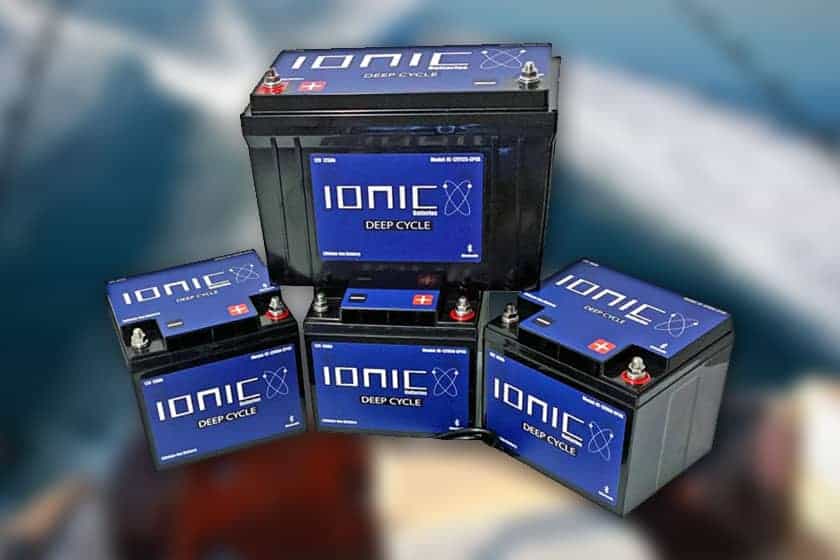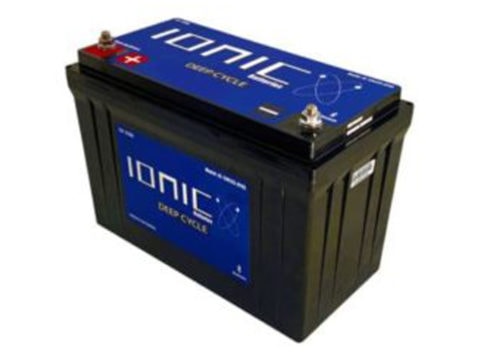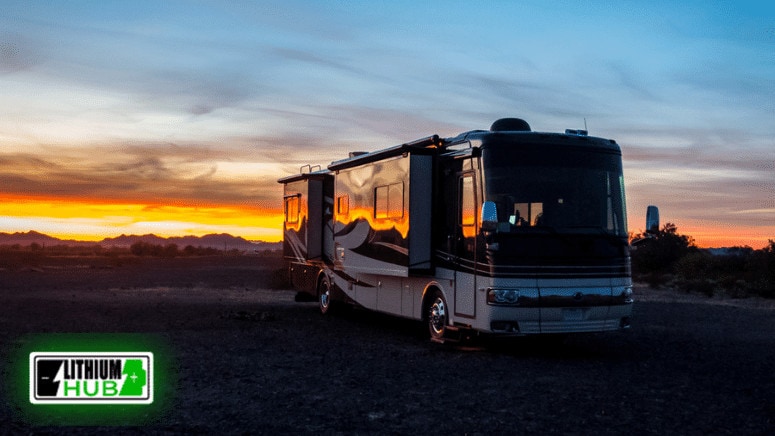Safety of Lithium Batteries
Lithium ion batteries come in many variations. Advantages of the NCA are high specific power for exuberant acceleration and long life. The negatives are high cost and a lower safety margin than other Li-ion systems. Figure 2 outlines six of the most important characteristics of a battery in a spider web.
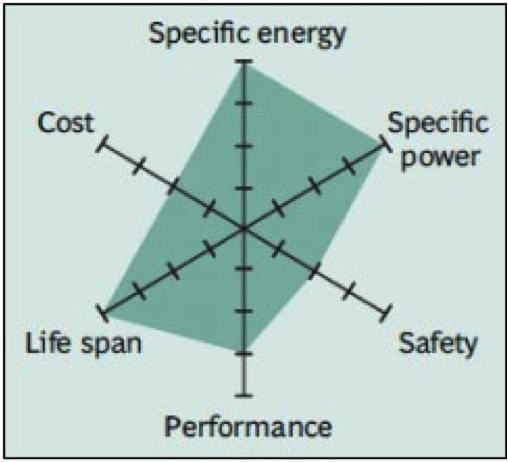 Figure 2: Snapshot of NCA spider web
Figure 2: Snapshot of NCA spider web
NCA offers high specific energy and power, as well as a long life span. Increased manufacturing cost and lower safety margin are negatives.
Batteries for the electric powertrain need high loading and a long life, and the NMC is another popular Li-ion system. NMC stands for nickel-manganese-cobalt and is also used in e-bikes, power tools and military and medical devices. The cathode consists of one-third nickel, one-third manganese and one-third cobalt. This unique blend lowers the raw material cost due to reduced cobalt content. Figure 3 demonstrates the characteristics of the NMC.
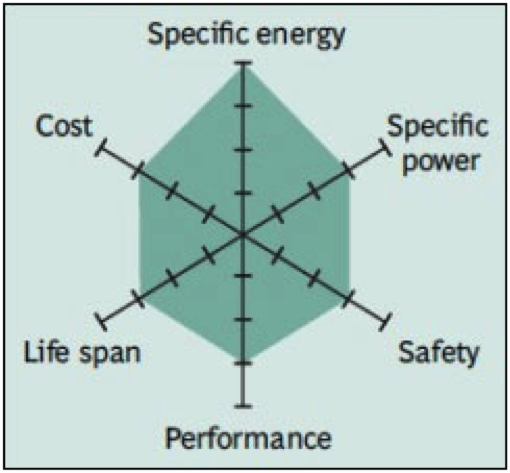 Figure 2: Snapshot of NMC
Figure 2: Snapshot of NMC
NMC has good overall performance and excels on specific energy. Typical applications are electric powertrains and portable devices. NMC has the lowest self-heating rate.
Another popular Li-ion system for electric powertrains is the Lithium Iron Phosphate (LiFePO4). Its strengths lay in long life and superior safety, but the chemistry lacks specific energy. A further tradeoff is the lower nominal voltage of 3.3V/cell rather than the customary 3.6V/cell of other Li-ion systems. Figure 4 summarizes the attributes of Li-phosphate.
 Figure 4: Snapshot of a typical Li-phosphate battery
Figure 4: Snapshot of a typical Li-phosphate battery
Li-phosphate has excellent safety margins and a long life span but offers moderate specific energy and elevated self-discharge.
Lithium-ion has much improved. In 1994, the capacity of an 18650 cell was 1,100mAh with a manufacturing cost of over $US10. In 2001, the price dropped to $2 and the capacity rose to 1,900mAh. Today, high energy-dense 18650 cells deliver over 3,000mAh and the costs have gone down further. This, however, does not come without compromise. Newer cells are more delicate than older ones this can affect the cycle count.
A Swiss manufacturer of upscale e-bikes did a comparison on older and newer cells. They use the NMC 18650 cell by Panasonic and LG Chem. The early version had 2Ah and delivered 80% after the onboard Battery Management Systems (BMS) indicated 1000 cycles. Then came the 2.2Ah NMC and the capacity dropped to 70% after 1000 cycles. The 3Ah NMC used today drops to 60% after 1000 cycles. It should be noted that the end-capacity of newer cells is still higher that the older ones; the 3Ah cell retained 1.8Ah after dropping 60% whereas the 2Ah cell ended up with only 1.6Ah after its 20% drop.
EV batteries must carry an eight-year warranty. To achieve this, a new battery may only charge to 80% and discharge to 30%. As the battery loses capacity with age, the BMS gradually increases the charging bandwidth to maintain a repeatable driving range. With the eventual full bandwidth in place, the battery will be stressed more, reflecting in a quicker drop in performance and reduction of driving range.
Cold temperature causes the performance of all batteries to drop. A bitter cold also makes charging more difficult, especially with Li-ion. Charging is more delicate that discharging; the ability to use a battery at low temperature does not automatically permit charging under these same conditions. Carless charging at low temperatures can inflict permanent damage to the battery.
Li-ion should not be charged below zero degree C (32°F). Some battery manufacturers permit charging down to -10°C (14°F) by reducing the charge current to a tenth of the battery rating, or 0.1C, a charge that would take 12–15 hours on an empty battery. Charging too fast at low temperatures could cause dendrite growth, but manufacturers say that battery safety should not be compromised.
The battery stress is highest at 4.20V/cell when the battery reaches full charge. Keeping a lower voltage also protects the battery during cold-temperature charging and some BMS limit the voltage and current accordingly. Many EV batteries include a heating blanket to protect the battery when charging at cold temperature. Energy to heat the blanket is available from the grid.
EV owners want ultra-fast charging and technology is available to do so. Although convenient, fast-charging is harmful to the battery. If at all possible, avoid charge times that are less than 90 minutes. The onboard BMS keeps record of stressful battery events and historic data can work against a warranty claim. This was the response of a large European EV manufacturer when the question of ultra-fast charging came up at a recent EV battery convention in London.
Safety is a further concern, but this applies to all batteries. A one-in-200,000 failure triggered the recall of almost six million lithium-ion batteries in 2006. Sony, the manufacturer of these cells, said that on rare occasions microscopic metal particles may come into contact with other parts of the battery cell, leading to a short circuit than can cause venting with flame.
Li-ion has improved and the failure rate has been reduced to one-in-10 million. This is reassuring, but the formula of one-in-10 million could cause 200 cells to fail in the batch of two billion that Tesla plans to consume. It is likely that the failure rate has gone down further but caution is in place when storing tons of batteries in one place. Fires with battery manufacturers and in warehoused storing batteries are common.
Little is known on premature aging when batteries are exposed to harsh environmental conditions. Internal shorts and rapid disassembly are of concern, an event that no safety circuit can stop once in progress. The fault occurs inside the cell and the battery must burn out.
In the early 1970s, the National Transportation Safety Board reported several battery incidents per year involving the then new nickel-cadmium. A redesign eventually made NiCd safe; this will also happen to Li-ion.
Transporting batteries by air remains a concern. There are regulations as to how much metallic (or equivalent) lithium can be included in an air shipment. Some content may go unregistered and the United Arab Emirates General Civil Aviation Authority found with reasonable certainty that the fire aboard the UPS 747-400 freighter was caused by a lithium battery. The aircraft went down on September 2010 in the Dubai desert about an hour into its flight to Cologne, Germany.
New air cargo containers are being developed and tested with material that can withstand intense fires for up to four hours. This will allow the preparation of an emergency landing on most flights. The fire-resistant panels of these air cargo containers consist of fibre-reinforced plastic composite that snuffs fire by depriving it of oxygen.
A fire is easier to put out in the cabin than in the cargo bay and since January 2008 people can no longer pack spare lithium batteries in checked baggage. Airlines allow them as carry-on where fire extinguishers are available. A coffee pot served as an extinguishing device of a flaming laptop battery in one incident. Travelers are reminded of how many batteries can be carried on board in portable devices and as spares. This also includes primary lithium batteries and the maximum measured in grams are:
- 2 grams for lithium batteries. Few consumer products use these primary batteries today.
- 8 grams for a secondary lithium-ion. This amounts to a 100Wh battery (laptop has about 60Wh)
- 25 grams for all Li-ion combined. This amounts to 300Wh worth of Li-ion batteries.
While Li-ion is being scrutinized for safety, other chemistries also exhibit problems. Nickel- and lead-based batteries cause fires too, and some are being recalled. Reasons for failure are defective separators resulting from aging, rough handling, excessive vibration and high-temperature.
Examining 113 recorded incidents of transporting batteries by air in 19 years reveals that most failures occurred due to inappropriate packaging or handling. Damaged battery pack and electrical short due to careless packaging were the main culprits. Most incidents happened at airports or in cargo hubs. Problem batteries include primary lithium that contains lithium-metal, as well as lead, nickel and alkaline systems, and not just lithium-ion, as is perceived. Modern consumer products have very few failures involving Li-ion batteries today.
Information from: www.batteryuniversity.com
